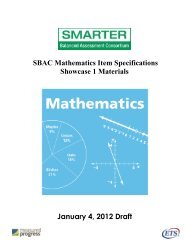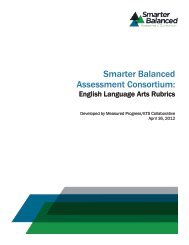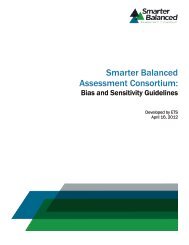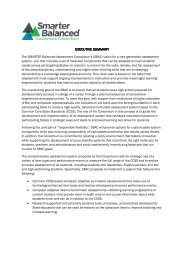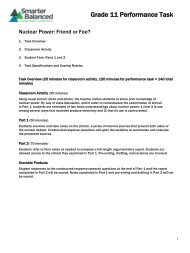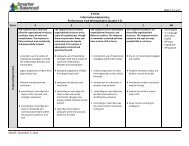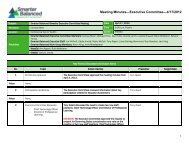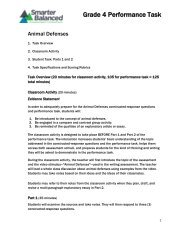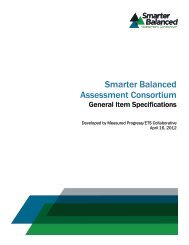Content Specifications for the Summative Assessment of the ...
Content Specifications for the Summative Assessment of the ...
Content Specifications for the Summative Assessment of the ...
You also want an ePaper? Increase the reach of your titles
YUMPU automatically turns print PDFs into web optimized ePapers that Google loves.
claims and assessment targets <strong>for</strong> test design than <strong>the</strong> CCSS document did <strong>for</strong> its purposes.<br />
A brief summary <strong>of</strong> <strong>the</strong> development connections between <strong>the</strong> Consortium’s assessment design <strong>for</strong><br />
ELA/Literacy and <strong>the</strong> Common Core State Standards<br />
<br />
<br />
<br />
<br />
The development process began with an in-depth analysis <strong>of</strong> each standard in <strong>the</strong> CCSS<br />
document in every strand, at every grade level: All CCSS ELA and literacy standards in each<br />
strand at each grade level were initially considered as <strong>the</strong> starting point <strong>for</strong> <strong>the</strong> large-scale,<br />
summative assessment. Both <strong>the</strong> content and implied cognitive demand <strong>of</strong> each standard was<br />
analyzed. Given <strong>the</strong> large number <strong>of</strong> standards to consider at each grade level (many more<br />
standards and a wider scope than any state has assessed in <strong>the</strong> past with a large-scale<br />
assessment), prioritization was needed to determine which standards should or could be<br />
emphasized and still provide meaningful assessment data to schools and teachers. It was<br />
determined as well that some aspects <strong>of</strong> a given standard lent <strong>the</strong>mselves to <strong>for</strong>mative ra<strong>the</strong>r than<br />
summative assessment. (See final WestEd report, March 2011 at<br />
http://www.k12.wa.us/SMARTER/pubdocs/SBAC_CCSS_Eligible_<strong>Content</strong>_Final_Report_030411.pdf.)<br />
An initial design decision was to assess reading abilities applied to <strong>the</strong> two broad text types<br />
identified as <strong>the</strong> focus <strong>of</strong> two sub-strands in <strong>the</strong> CCSS: Reading assessment targets <strong>for</strong> Claim #1<br />
address both literary and in<strong>for</strong>mational texts and make specific distinctions that align with CCSS<br />
standards <strong>for</strong> reading literature (RL) or reading in<strong>for</strong>mational (RI) texts. Attention to reading<br />
closely and reading texts <strong>of</strong> increasing complexity at all grade levels – ideas stressed in <strong>the</strong> CC -<br />
have been incorporated into <strong>the</strong> wording <strong>of</strong> Claim #1 (Students can read closely and analytically<br />
to comprehend a range <strong>of</strong> increasingly complex literary and in<strong>for</strong>mational texts) and applied to<br />
descriptions <strong>of</strong> what sufficient evidence <strong>of</strong> student per<strong>for</strong>mance should look like <strong>for</strong> this claim.<br />
A second decision was to assess writing <strong>of</strong> three specific text types identified as <strong>the</strong> focus in <strong>the</strong><br />
CCSS: Writing assessment targets <strong>for</strong> Claim #2 address all three text types (W1,<br />
opinion/argument, W2, in<strong>for</strong>mational, and W3, narrative writing) and <strong>the</strong>ir unique features.<br />
<strong>Assessment</strong> targets <strong>for</strong> claim #2 make specific distinctions that align with CC standards <strong>for</strong> each<br />
type <strong>of</strong> writing at every grade level. The wording <strong>of</strong> Claim #2 (Students can produce effective<br />
and well-grounded writing <strong>for</strong> a range <strong>of</strong> purposes and audiences) and descriptions <strong>of</strong> what<br />
sufficient evidence <strong>of</strong> student per<strong>for</strong>mance should look like address all three writing purposes.<br />
The instructional emphasis recommended in <strong>the</strong> CCSS was applied to assessment emphasis,<br />
while considering what content would be appropriate and practical to include <strong>for</strong> a summative<br />
assessment: Prioritization criteria <strong>for</strong> selecting standards (or parts <strong>of</strong> standards) to be assessed at<br />
<strong>the</strong> end <strong>of</strong> each grade level included <strong>the</strong> following:<br />
(a) <strong>Content</strong> identified in <strong>the</strong> CCSS document as having greater emphasis at different grade levels<br />
was given <strong>the</strong> highest priority. For example, <strong>the</strong> CCSS calls <strong>for</strong> shifting <strong>the</strong> emphasis on reading<br />
literary and in<strong>for</strong>mational texts across grade levels; it calls <strong>for</strong> greater emphasis on writing arguments<br />
at high school than on narrative writing; it emphasizes writing opinions/arguments in response to<br />
reading texts, and conducting short research projects.<br />
16<br />
(b) <strong>Content</strong> that could be assessed in an on-demand, large-scale setting was identified and<br />
compared with high emphasis CCSS content. An earlier document created by WestEd <strong>for</strong> SBAC<br />
identifying “eligible content” <strong>for</strong> assessment was reviewed during <strong>the</strong> prioritization process.



